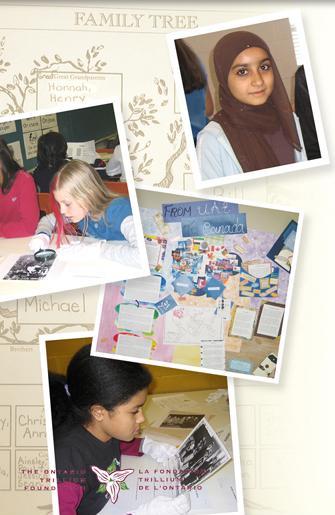Unit Summary
Adapted from Mr. Burns Wattie's Unit Summary and assignments created by all participating teachers.
The Family Stories unit is divided into three main parts:
- the family interview
- research
- publishing the displays
(Please note that in the event that a family interview is not possible, a neighbour, role model or community member could be interviewed instead.)
The unit is flexible. It can be completed as:
- a short unit as an introduction to History
- a short unit as a language activity
- a short or long Migration unit (Geography)
- a longer cross-curricular unit and culminating end of year project
- a long term cross-curricular project spread throughout the school year
Please note that the Family Stories program will vary widely depending on grade level, type of project assigned and extent of parental support. For example:
- For grade 5-6 students or as a language activity for grade 7-8 students, the research can focus on preparing for the family interview, as well as compiling and learning about family objects and photos to present the family story.
- As an introduction to History for grades 7-8, the research can focus on the richness of the interview and efforts to collect items or create artwork to illustrate or support the family story. Students inevitably learn broadly about historical events through their classmates' projects and can begin to think about their interconnections with each other and communities at large.
- As a culminating project or longer term project, much more time can be spent researching the historical context of the family history, including the history of their family group arrival (either in Canada or in their present location), history of their community in Canada, etc. If the program is spread throughout the year, the family interview should be done in the first or second term with the research aspect done in the third term.
The family interview section involves students interviewing their parents and constructing a narrative as a result. The research section requires independent research into how their cultural group came to Canada or moved within Canada.
For grade 7-8 students completing a longer-term research project, the research part presents a potentially difficult reading challenge that will need to be carefully scaffolded and monitored. The students will be primarily using the internet and finding diverse sites that were not written with young students as an audience. Some sites may be geared towards university audiences, while others will espouse an openly extremist view of a particular group. Some countries may be difficult to research, and in all cases, the parents should be involved in providing perspective and connection. For these reasons, it is advisable to do this section of the project as a culminating research task in third term, having already attempted more predictable historical research in their History program (i.e. webquests on the War of 1812, American Revolution, Early French settlement).
The culminating task is the preparation of a display that includes the final products of the family interview, the research work, mapping activity, reflection as well as any other components. Since the students will have put considerable time and effort into it, it is strongly suggested that a venue for a more public display be found. School wide parent attended events are one possibility, as are displays in a local library, a school entrance display, or at a community event. This public display aspect will also help the students do their best work.



